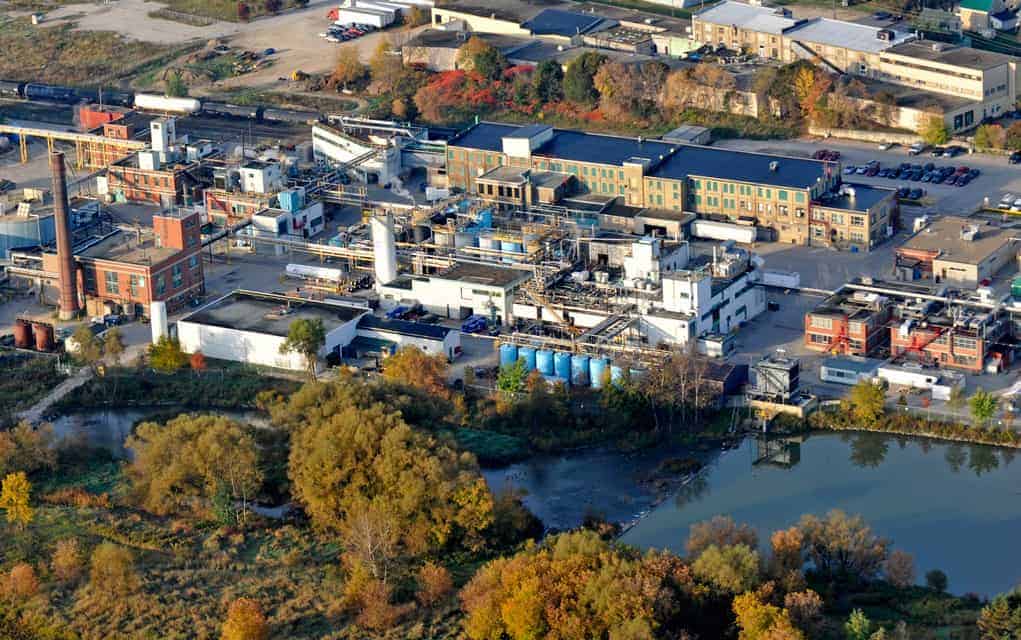An environmental group calling for quick action on dealing with contaminants from the Chemtura chemical plant in Elmira is in no way mollified by a recent report from the company.
The Citizens Public Advisory Committee (CPAC) – members of what was the Chemtura Public Advisory Committee before it was disbanded by Woolwich Township – take issue with a recent report from the chemical company showing few concerns about contaminants on the south and east boundaries of the property.
That Chemtura report, prepared by consultants GHD (formerly Conestoga-Rovers and Associates), found elevated levels of DDT, dioxins and furans, but didn’t look at offsite migration. The study looked at surficial soil and groundwater on the boundary lines of the property.
In a report released this week, CPAC’s Graham Chevreau said Chemtura’s press release about its study was at odds with some of the GHD findings.
“Contrary to the company’s press release assurance that ‘the 2015 groundwater samples from the southern site boundary confirm that very few site-related contaminants are present, and none are at concentrations that exceed their respective groundwater criteria,’ the GHD report actually confirms the fact that the site is an uncontained hazardous waste site and has contaminated adjacent residential and agricultural properties.”
In the former CPAC’s final report to council last summer before it was disbanded in favour of a new public advisory format, Chevreau presented a long list of concerns about contaminants migrating off the site. At the time, the group called on council to press for more action from the Ministry of the Environment, arguing its study shows pollutants are leaching from the site into the Canagagigue Creek.
A CPAC-commissioned study that found elevated levels of DDT in the creek downstream of the chemical plant – 20 to 2,900 times higher than the applicable Ontario Maximum Allowable Concentration standards – is an indication pollutants are migrating offsite, the group argued at the time.
At that time, the company said it planned to push ahead with a soil and groundwater study of its own to look at contaminants along the boundary. Released earlier this month, that report found fewer problems than CPAC reported.
“Based on the results of the groundwater investigation, GHD confirmed that there is little evidence of impact from past waste disposal practices. The 2015 groundwater samples from the southern site boundary confirm very few site-related contaminants are present and none are at concentrations that exceed their respective groundwater criteria,” the report found.
Chemtura’s manager of environmental remediation, Jeff Merriman, notes the two studies, CPAC’s and its own, aren’t directly comparable.
“We weren’t looking at exactly the same thing,” he said in an interview last week. “Our study was focused right on the fence line.”
CPAC’s study, however, looked downstream and at a neighbouring property.
Still, said Merriman, the CPAC report of DDT in creek sediment was “not a surprise,” as the company has known for years about the old contaminants. Monitoring shows the contaminants are “localized and in the first foot of soil.”
Chemtura will be doing additional modeling and testing, added Dwight Este, the plant’s environment, health and safety manager.
“We’re committed to working with the parties to address these concerns.”
The GHD report also recommended the installation of a silt fence along the eastern site boundary to mitigate any potential overland flow of contaminants.
Chevreau notes the report doesn’t deal with the issues raised in CPAC’s study, carried out by Peter Gray of MTE Consulting.
“No surficial soil samples, no subsurface samples, and no groundwater samples were collected along an extensive low lying portion of the east side property boundary – a distance of approximately 160 metres in length. This is the precise location of the east side drainage ditch which was specifically identified as requiring investigation by Peter Gray.”









